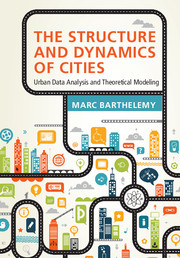Book contents
1 - Urban systems
Published online by Cambridge University Press: 10 November 2016
Summary
In this first chapter, we propose a rough, synthetic view of cities, by retaining what we believe to be some salient features from a quantitative point of view. There are many books and reviews, giving countless details and figures about cities (in particular, the reader can consult the updated version of reports produced by the UN – see for example “World urbanization propects, the 2014 revision”), and instead of offering a long list of various properties of cities (which can be found in different books and reliable sources such as the Census Bureau for the US, the UN, the OECD, or the World Bank), we focus here on a small set of key figures and discuss important scales manifesting in cities.
Cities are complex objects with many different temporal and spatial scales, related to a large number of processes. While a small set of numbers is certainly not enough to describe the full complexity of cities, such numbers can nevertheless allow for quantitative studies and for a large-scale characterization of urban systems. There is much variety among cities in terms of morphology, population, density distribution, and also functions, yet despite these differences, we observe statistical regularities for some observables. Indeed, we can expect that large systems composed of a large number of constituents lead to collective behaviors characterized by statistical regularities. Another reason for this “universality” is the existence of fundamental processes common to all cities: spatial organization of activities and residences, mobility of individuals, and so on. One of the most challenging problems of a science of cities is then to identify the minimal set of mechanisms that describe the evolution of cities.
A science of cities
The nature of the problem
A central issue in understanding urbanization is the large number of entangled, time-varying processes that generate cities. Many disciplines such as quantitative geography or urban economics have addressed some aspects of this problem and produced either very abstract models, or, at the other extreme, simulations with very large numbers of parameters designed for specific locales.
- Type
- Chapter
- Information
- The Structure and Dynamics of CitiesUrban Data Analysis and Theoretical Modeling, pp. 1 - 24Publisher: Cambridge University PressPrint publication year: 2016



